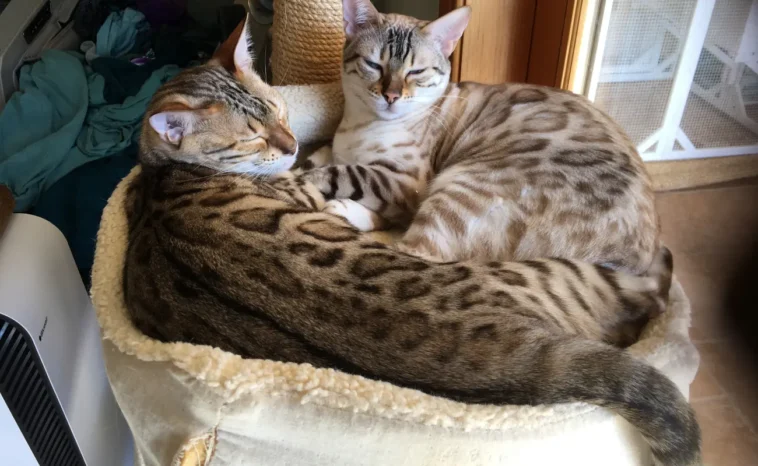Introduction
Are you on the hunt for the perfect feline companion that will fit right into your family dynamic? Look no further than this Top 10 Best Cat Breeds for Kids and Families (2025 Guide)! Whether you’re a long-time cat lover or new to caring for kittens, this comprehensive resource will help you choose the right pet for your household. In this Top 10 Best Cat Breeds for Kids and Families (2025 Guide), we’ll discuss the friendliest, most adaptable cats to keep your children engaged and happy while also ensuring a smooth and loving experience at home. You’ll learn about breed-specific traits, challenges, tips for training, and so much more.
Before we dive into the details, here’s a quick recommendation for further reading: check out our article, 10 Best DIY Pet Projects to Try at Home (Fun & Easy Ideas!) for creative ways to enrich your cat’s environment. These do-it-yourself projects are perfect if you’re looking for simple, low-cost ways to keep your feline friends active and entertained. Now, let’s get into the heart of things: a closer look at the best cat breeds for children and families, along with practical advice and expert insights to help you make the best decision.
Top 10 Best Cat Breeds for Kids and Families (2025 Guide)
1. Overview
When searching for family-friendly cats, most people want cat breeds that are gentle, playful, and adaptable. Children can be energetic and curious, which means the ideal feline companion should be patient, tolerant, and ready to engage in some playful antics without being overly stressed. In this overview, we’ll look at core considerations before you choose your new pet:
-
Temperament: Calm, outgoing personalities often integrate more smoothly into family life.
-
Adaptability: Breeds known for easily adjusting to change in routine or environment can help reduce stress for both the children and the cat.
-
Maintenance: Consider the amount of grooming and exercise a breed needs. This factor becomes important when delegating pet-related responsibilities to kids.
-
Activity Level: Some children thrive with a more active cat, while others may do better with a laid-back feline.
-
Health and Lifespan: Longevity and breed-specific health issues can be crucial in ensuring a long, happy relationship.
The following sections will dive deeper into specific cat breeds, their traits, and why they may be an excellent addition to your household. We’ll also explore helpful tips, common questions, potential challenges, and how to overcome them, as well as the benefits of having a family-friendly cat. By the time you finish reading, you’ll be well-equipped to make the right choice for your household’s newest member.
2. A Detailed Look at 10 Best Cat Breeds for Kids and Families
In this section, we focus on the key attributes of each breed, helping you decide which feline might best suit your family’s needs. Remember that individual personalities can vary within a breed, so it’s always essential to spend time with any cat before adoption.
2.1 Maine Coon
-
Temperament: Known as the “gentle giant,” Maine Coons are large, affectionate, and excellent with kids.
-
Activity Level: Moderate to high; they love interactive toys.
-
Maintenance: They have a long, thick coat that requires regular grooming.
2.2 Ragdoll
-
Temperament: Relaxed, docile, and famously known for going limp in your arms (hence the name). Great for families seeking a calm companion.
-
Activity Level: Generally lower energy but still playful enough to keep children entertained.
-
Maintenance: Medium-length silky coat—brushing a few times a week is helpful.
2.3 Birman
-
Temperament: Social and friendly, Birmans often thrive on human companionship.
-
Activity Level: Moderate; they enjoy both cuddle time and interactive play.
-
Maintenance: Semi-long coat that’s relatively easy to maintain.
2.4 British Shorthair
-
Temperament: Calm, dignified, and patient, making them suitable for kids.
-
Activity Level: Moderate; they enjoy toys but don’t require extensive exercise sessions.
-
Maintenance: Their short, plush coat is easy to care for with weekly brushing.
2.5 Abyssinian
-
Temperament: Inquisitive and highly energetic, perfect for active families who love an engaging pet.
-
Activity Level: High; Abyssinians are curious and need regular play.
-
Maintenance: Short-haired coat; straightforward grooming routine.
2.6 Siamese
-
Temperament: Vocal, intelligent, and social, Siamese cats form strong bonds with family members.
-
Activity Level: High energy; they need interactive toys and mental stimulation.
-
Maintenance: Short coat that’s easy to maintain, but be prepared to engage with them often.
2.7 Persian
-
Temperament: Gentle, calm, and loving, Persian cats enjoy tranquil environments but can handle respectful children.
-
Activity Level: Low to moderate; they prefer lounging but will engage in play if gently encouraged.
-
Maintenance: High grooming needs due to their long, luxurious coat.
2.8 Bengal
-
Temperament: Energetic and playful, these cats thrive in households where they receive a lot of attention.
-
Activity Level: Very high; they’re athletic climbers who love chasing games.
-
Maintenance: Short, dense coat; moderate grooming required, but daily exercise is crucial.
2.9 Scottish Fold
-
Temperament: Known for their sweet nature and distinct folded ears. Scottish Folds are affectionate and adapt well to families.
-
Activity Level: Moderate; they enjoy interactive toys and gentle games.
-
Maintenance: Short or long-haired varieties exist; both require regular brushing.
2.10 Sphynx
-
Temperament: Outgoing and social, Sphynx cats love being the center of attention.
-
Activity Level: High; they’re curious, mischievous, and need stimulation.
-
Maintenance: Although they’re nearly hairless, they require frequent baths to remove skin oils.

featuring friendly, playful felines.
3. Common Questions About Top 10 Best Cat Breeds for Kids and Families (2025 Guide)
Choosing from a variety of cat breeds can feel overwhelming. Here are some frequently asked questions to clarify concerns:
-
Which cat breed is the most low-maintenance for a busy family?
-
British Shorthairs are a popular choice due to their relatively low grooming requirements and calm temperament.
-
-
Are there certain breeds that are best for families with toddlers?
-
Breeds like Ragdolls or Maine Coons are generally patient and gentle, making them well-suited for younger kids.
-
-
How important is breed vs. personality when choosing a family cat?
-
Breed can guide you, but remember that each cat has a unique personality. Spend time interacting with a prospective pet to ensure compatibility.
-
-
What about allergies?
-
While no cat is truly hypoallergenic, some breeds like the Sphynx and Balinese produce fewer allergens. Still, individuals react differently, so test your sensitivities before committing.
-
-
Is adopting an adult cat better than a kitten for families?
-
Adult cats often have established personalities, allowing you to better judge their compatibility with kids. Kittens, while adorable, require more supervision and training.
-
4. Tips for Introducing and Caring for a New Family Cat
Bringing a new feline friend into your home is an exciting event, but it’s also important to plan carefully for a smooth transition. Here are some actionable tips:
4.1 Preparing the Home Environment
-
Designate a Safe Space: Set up a quiet area with a bed, litter box, and fresh water. This space helps the cat adjust gradually.
-
Child-Proofing: Make sure your children understand boundaries. Create rules like not pulling tails or disturbing the cat while it’s eating or sleeping.
-
Initial Isolation: For the first few days, limit your new cat’s access to just one room. This gradual introduction lowers stress and prevents overwhelm.
4.2 Introducing Cats and Kids
-
Supervise Early Interactions: Young children may unintentionally be rough. Demonstrate gentle petting and handling.
-
Positive Reinforcement: Give treats to the cat when it behaves calmly around kids. Offer praise to children for respecting the cat’s space.
-
Short Sessions: Keep initial playtimes brief to avoid stressing the cat.
4.3 Routine and Consistency
-
Feeding Schedules: Cats thrive on routine. Let children help feed the cat at designated times.
-
Play and Exercise: Encourage kids to have daily play sessions with interactive toys, which helps form a strong bond.
-
Veterinary Checkups: Regular vet visits ensure the cat remains healthy and that any issues are caught early.
5. Challenges and Solutions Related to Raising Family-Friendly Cats
While family-friendly cats tend to be more adaptable, challenges can still arise. Below are common difficulties and how to tackle them:
5.1 Overzealous Children
-
Challenge: Children may be too eager to play, potentially overwhelming the cat.
-
Solution: Teach kids about cat body language (e.g., swishing tail, flattened ears) as signs to give the cat space.
5.2 Scratching and Biting
-
Challenge: Even playful kittens may nip or scratch if overstimulated.
-
Solution: Provide scratching posts and interactive toys. Show kids how to use wand toys or laser pointers to direct the cat’s attention away from hands.
5.3 Allergies in the Family
-
Challenge: A family member suddenly develops allergies after adoption.
-
Solution: Regular grooming, air purifiers, and limiting the cat’s access to certain rooms (like bedrooms) can reduce allergic reactions. Consult your doctor and veterinarian for tailored advice.
5.4 Introducing Other Pets
-
Challenge: Households with existing pets, like dogs or other cats, might experience territorial tensions.
-
Solution: Use gradual introductions, separate feeding areas, and supervised play sessions. Allow each pet time to adjust.
6. Benefits of Having a Kid-Friendly Cat at Home
Opting for a feline companion that’s good with kids can bring countless advantages, including:
-
Emotional Support: Cats provide comfort and stress relief through purring and cuddling.
-
Teaching Responsibility: Children learn valuable lessons in compassion and routine when tasked with feeding, grooming, and cleaning.
-
Social Development: Pets can help shy children open up and practice gentle communication.
-
Physical Health: Studies indicate that exposure to pets can sometimes reduce the risk of allergies and asthma.
-
Family Bonding: Caring for a cat becomes a shared activity, helping siblings learn to collaborate on tasks like feeding or vet visits.
7. Expert Opinions or Research on Kid-Friendly Cat Breeds
Dr. Marissa Kaplan, a veterinarian with 15 years of experience specializing in companion animals, believes that breed-specific traits can act as helpful guidelines for families. According to Dr. Kaplan:
“While personality varies from cat to cat, certain breeds have consistently shown adaptability, gentleness, and social behavior. This makes them great options for families with children, especially if parents proactively guide their kids on responsible pet handling.”
Additionally, research published in the Journal of Feline Behavioral Science highlights that early socialization—exposing kittens to various sights, sounds, and gentle handling—plays a significant role in their adult temperament. Families that adopt kittens from reputable breeders or shelters where socialization is practiced often find it easier to transition new pets into family life.
Frequently Asked Questions (FAQ)
-
Can my older cat adapt to living with a new kitten?
-
Yes, but patience is essential. Introduce them slowly, offering each cat its own territory, and observe their interactions closely. With time, they often learn to coexist or even become friends.
-
-
How do I handle grooming for long-haired breeds with kids?
-
Turn grooming sessions into a bonding activity. Teach children how to use a soft brush or comb. Make it positive by offering treats or gentle praise so the cat remains calm.
-
-
Are indoor or outdoor cats better for families with kids?
-
Indoor cats are generally safer and face fewer risks from traffic, predators, and diseases. Families can invest in cat towers or leash training for controlled outdoor exploration.
-
-
What’s a simple way to keep cats entertained when children are at school?
-
Interactive toys such as puzzle feeders or automated laser pointers can keep your cat mentally stimulated. Rotate toys to maintain your feline’s interest.
-
-
How can I tell if a cat is overwhelmed by my children?
-
Watch for signs of stress like flattened ears, a twitching tail, or hiding. Encourage kids to give the cat space and reduce the intensity of play if these signs appear.
-
Conclusion and Call-to-Action
Choosing the right feline for your household is crucial. As you’ve learned in this Top 10 Best Cat Breeds for Kids and Families (2025 Guide), you have a wealth of options—ranging from easygoing Ragdolls to playful Bengals. Each breed offers unique qualities, and individual personalities can vary, so always spend time interacting with a prospective cat before making a final decision.
Remember to introduce your new pet slowly, teach children proper handling, and keep up with regular grooming and vet visits to ensure a healthy, happy kitty. For more fun ways to engage with your cat, revisit our internal link: 10 Best DIY Pet Projects to Try at Home (Fun & Easy Ideas!).
Ready to bring a kid-friendly cat into your home? Share your thoughts or experiences in the comments below, or pass this guide along to friends and family. By doing so, you’ll help even more people discover the joys of raising a cat that harmonizes beautifully with kids and the entire household.





GIPHY App Key not set. Please check settings
One Comment